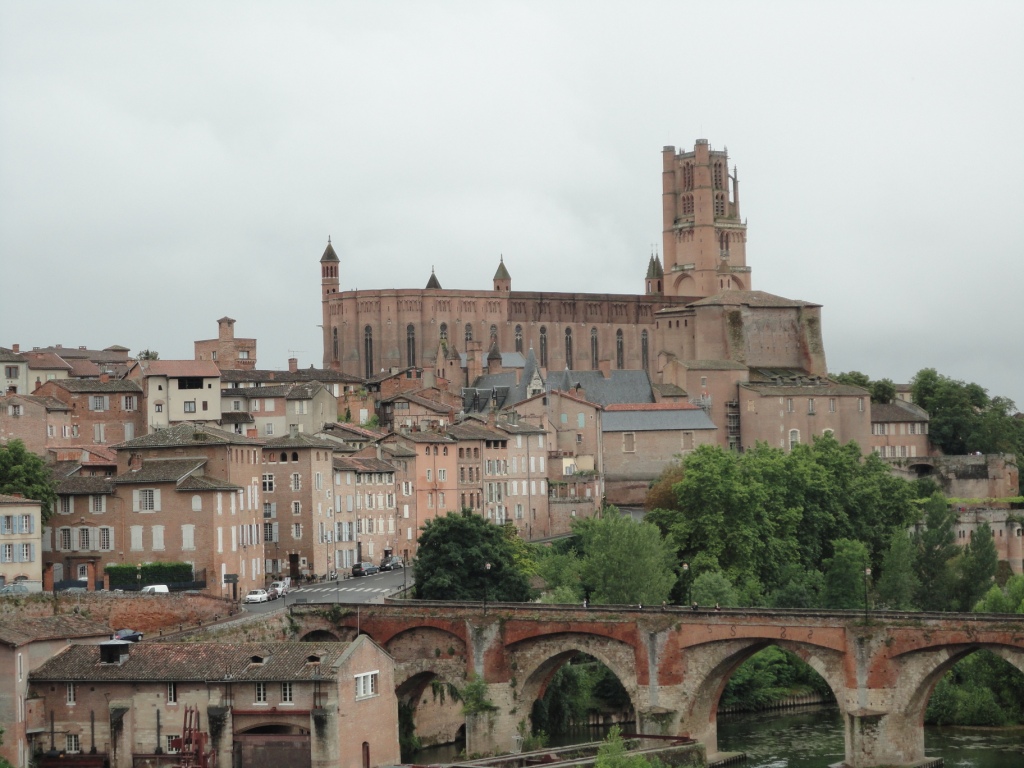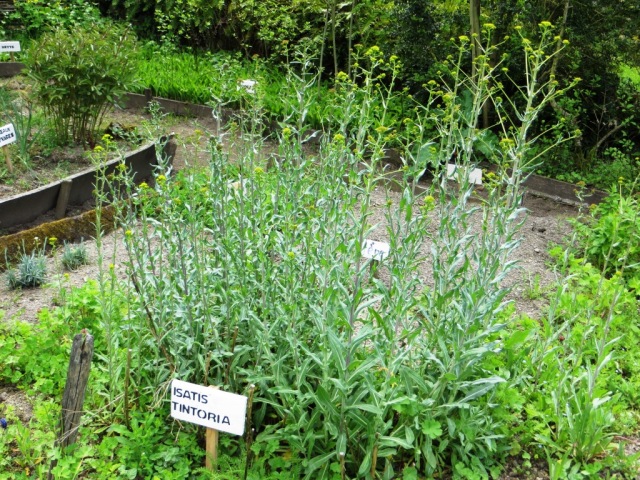
Albi and Toulouse experienced a golden age during the late medieval and Renaissance periods, founded on the trade in pastel dye. I had vaguely heard of pastel (woad) but knew little about it. Visiting and reading up on these places recently prompted me to do some research about it.
Pastel takes off
Pastel is a plant, Isatis tinctoria, which produces an indelible blue dye, following an elaborate manufacturing process. Well known by the ancient Egyptians, the plant was already cultivated in the Lauragais region southeast of Toulouse by the 12th century, where the soil and climate were particularly suitable.
Cloth manufactured locally in the region was of inferior quality whereas pastel was an expensive luxury, so local demand was minimal. However, increasing demand for the dye by English and Flemish cloth manufacturers led to production and export on a large scale. The trade became highly organised with farmers cultivating the plants, collecteurs buying the leaves and manufacturing the dye and merchants organising its marketing and export.
Trade routes were established to the major Atlantic ports, up to Lyon and the Low Countries and down into Spain. Apparently, on the 8th November 1404, 13 ships from Bayonne and four from Bordeaux landed 127 cubic metres of pastel at Bristol. This gives some idea of the extent of the trade by that date.
Initially, Albi was the centre of the pastel trade in the 14th century. Toulouse soon overtook it for various reasons, including the superiority of its banking structure, which provided a stable commercial basis for the trade. The Toulousain pastel trade experienced a golden age between the mid-15th and mid-16th centuries. Merchant families amassed vast fortunes, which they spent conspicuously on constructing opulent mansions in the city.

The Albi-Toulouse-Carcassonne triangle became known as the ‘Pays de Cocagne’ (Land of Plenty), a word that derives from the balls of paste (Occitan coucagno) formed during the manufacturing process. The nickname became synonymous with wealth and abundance.
Making pastel
Cultivating the plants and making the dye was a labour-intensive cycle taking a whole year:
- Seeding took place in February/March and the leaves were harvested from June to November and then washed and dried. The yellow flowers played no part in the process.
- The leaves were shredded and pounded into a pulp in special pastel mills, moulins pasteliers.
- The pulp was dried for six months, during which time a first fermentation took place, allowing the pulp to be formed into balls 10-15 cm in diameter (the coucagno or cocagnes). The balls were then dried.
- Once dry, the balls were crushed and wetted to obtain a second fermentation. This produced a black, granular paste called agranat.
- To obtain the blue dye, a green juice was extracted from the agranat and oxidised.
This produced a dye that was highly prized not only for its colour but also for its indelible qualities. The weight of the final product was about 7% of the weight of the original harvest – hence its high price.
Decline and fall
All good things come to an end and pastel was no exception. Several reasons conspired in the decline of the pastel trade from 1560. First, the development of dubious practices undermined the merchants’ credibility, including wetting the sacks containing the pastel to make them heavier and adding less expensive substances like sand to the agranat while maintaining the prices. Second, heavy rainfall led to abundant crops but poor quality. Third, the Wars of Religion disrupted the trade routes from 1562. Finally, the introduction of indigo, which was more concentrated, easier to use and much cheaper displaced pastel production.
Some suggest that the growers’ and merchants’ failure to invest in the pastel industry was also a factor. The merchants preferred to pursue political ambition and construct lavish houses outside the areas of production rather than develop cultivation and production methods.
Attempts to revive the trade in the 18th century by simplifying the cultivation of pastel and getting it protected by royal warrant were unsuccessful. Napoleon also attempted to revive it and a school of pastel production was even set up, but a series of poor summers and the fall of the Empire in 1823 tolled its final death knell.
A company based in Lectoure (Gers) has revived the art of pastel making and produces dyes, paints and cosmetics.
Copyright © 2011 Life on La Lune, all rights reserved

[…] Getting the Blues: The Pastel Trade in Southwest France […]
LikeLike
[…] Getting the Blues: the Pastel Trade In Southwest France […]
LikeLike
[…] Getting the blues: the pastel trade in Southwest France […]
LikeLike
[…] Getting the Blues: the Pastel Trade in Southwest France […]
LikeLike
[…] Number 5: Getting the Blues: the Pastel Trade in Southwest France […]
LikeLike
[…] Getting the Blues: the pastel trade in southwest France […]
LikeLike
[…] Cut Above the Rest: Laguiole Knives Getting the blues: the pastel trade in southwest France Saffron: Quercy’s Red […]
LikeLike
[…] in the Middle Ages. I now know what Sarriette and Isatis Tinctoria (woad, from which they made pastel dye) look […]
LikeLike
[…] Getting the Blues: the Pastel Trade in Southwest France – this is one of a number of posts on the blog that look at trades or products that were formerly of great importance to the regional economy. Others are saffron, violets and phosphate mining. […]
LikeLike
[…] tinctoria is, of course, the botanical name for woad, known for centuries as a potent blue dye. The pastel trade was once very important to the regional economy. The other two were as well. Crocus sativus […]
LikeLike
[…] Wine Blight: How the French Wine Industry was almost Wiped Out Bach, an Ancient Village on the Causse de Limogne Getting the blues: the pastel trade in southwest France […]
LikeLike
[…] has a shop right by the cathedral in Albi with rather lovely blue scarves and lots of other things. Vanessa France’s blog has more on the history of the pastel […]
LikeLike
Did you see the recent article where a new “blue” has been developed at Oregon State? Using manganese and several other chemicals heated to 2000 degrees they derived a pigment that’s nontoxic and very stable.
It’s really quite circumstantial that I stumbled upon your article. In the background right now is the travel program with Burt Wolf exploring southwest France and is showing the great buildings in Toulouse built during the same period.
According to him, blue has been considered evil and bad because the Romans, Caesar specifically, associating the color to the barbarians who painted their bodies just before battle. And it was the rise of the pastel industry that triggered the change of attitudes.
In addition to this coincidence, last night my wife and I were having a debate about the first use of blue and how the pigment was produced. She thought the Egyptians used indigo. I thought they had used sea shells of a small snail found in the Mediterranean.
Therefore, in my view, blue is the new orange, uh, black! Number one on my bucket list is to visit southern France.
Take care! C’est bon!
LikeLiked by 1 person
Thanks for this interesting information. I hadn’t heard about the synthesising of the blue pigment. It was always a very labour-intensive and unstable process and, although they tried to revive it later on, it never took off again. Interesting thoughts about the early origins of the blue pigment, too. I hope you enjoy southern France (we are in the SW) if you come. Plenty to see!
LikeLike
Vanessa, I’m ashamed to say I’ve lived in Lectoure, on and off, for the past year and have not yet made the Bleu de Lectoure visit. I can only plead house renovations as an excuse. Reading this post is an added spur to make that visit!
LikeLike
I know just how it is, Jackie. There are countless things over here that we have not seen or done in 14 years and I never cease to feel embarrassed when people say, ‘Oh you must have seen the Millau Bridge’, for example. Bleu de Lectoure sounds intriguing; I’m not aware of any other attempts to revive pastel making. I hope you find it interesting when you visit.
LikeLike
Must forward this to my friend Elisabeth de la Perouse Coleman, who is a descendent of the explorer and whose family originally made their fortune in the pastel trade in Albi.
LikeLike
How interesting. By all means share it with your friend. I’m sure she knows much more about it than I do so I would be very pleased to know her thoughts about it, especially if I have got anything wrong.
LikeLike
Perfect post, Vanessa – history, language and colour!
LikeLike
Thanks, Deborah. I wish I’d had a more apposite photo. There are some good ones on the site I mentioned of the company that has revived the art of making pastel.
LikeLike
Really fascinating, Vanessa. I’m very taken by the woad oil soap on the Bleu de Lectoure site, and by the novel ‘Pastel’, but I think 394 pages of French might be a little ambitious for me!
LikeLike
Thanks, Stephanie. I didn’t realise they sold books as well on that site – I didn’t look thoroughly enough. I might have a go at that novel – I’m sure you can manage it! I also like the idea of some of the soaps etc.
LikeLike